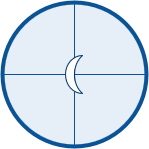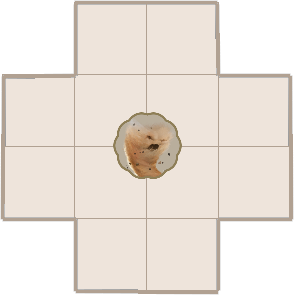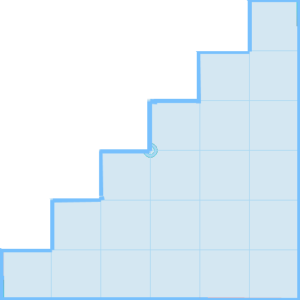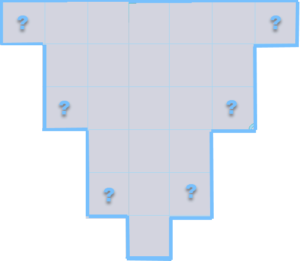For my Princes of the Apocalypse game (which we ran on Roll20 with a standard 5-foot grid), I built some Roll20 AoE templates for spells, to make it easier to see and use the AoE and to provide a longer lasting way to show a still-active area spell.
So why is this needed?
There are ways to show the area of a spell. At a minimum, you can draw something on the screen — but that gets messy and not always easily movable. It’s also hard to draw some shapes, like cones.
Also, even if you draw something with the circle tool, you have two problems — precisely knowing the center point to anchor it on, and, more importantly, clarity on what squares are affected by the spell or not. Yes, you can interpolate (“I think that’s less than half the square”), but that’s just argument fodder.
Roll20 and various adjuncts to it provide area tools for AoEs (Roll20’s native tools have improved dramatically of late), but they still have a couple of problems. First, again, they are actual geometric figures (e.g., circles), so interpolation is still needed. Second, they are non-persistent — you can set them to Linger, but a player can only have one up at a time (I’m not sure if two players can have theirs up simultaneously); you can maybe eke by for that initial Fireball, but if you have a Spike Growth that stays up for a long time, you’re back to drawing a circle on the map.
What I wanted was a way that players could express a proper spell area (cones, squares, circles, even rectangles) in full squares, that they could move as needed for placement, and that would let me (as the DM) resolve the effects on those within the area, whatever the shape, and that could be left on the map for non-instant duration spells.
The answer: AoE templates.
Now coming to a marketplace near you
You can buy spell templates in the Roll20 marketplace. In fact, I did.
Unfortunately, the ones I bought turned out to be one or more of:
- Obtrusive (covering up too much of the underlying terrain).
- Ugly (a judgment call on my part, to be sure)
- Wrong (there are different ways of calculating a 15-foot or 20-foot radius circle on a grid, partly based on whether you are centering on a square middle or on a square corner. Who knew?) (And D&D 5e renders cones differently from other editions or systems.
I wanted something that would be:
- Largely transparent — clear enough to be visible, but not blocking the map people were on.
- Reasonably attractive
- Correct, based on my reading of how (especially) cones and circles/spheres work, including anchoring on a grid vertex (corner), not (except in rare, specified occurrences) on the centers of grid squares.
So, after a couple of failed tries, I decided to roll my own.
Rolling my own
I used a drawing program I have to basically build up a sample AoE as a drawing, trimmed to the edges, with transparency on anything outside of the borders. There would be a grid within the AoE, with solid borders along the grid, and the squares inside tinted but mostly transparent, with a slightly thicker border around the edges to make its boundary clear. I sized it to fit a 70 pixel cell grid.
For a given shape (a 20-foot radius circle, for example), I usually started with something gray. I could then use the color select / color dump functions to remake it into different colors based on the type of spell — orange for a Fireball, green for a Spike Growth, etc.
Once I had a drawing how I wanted it, I uploaded it to my Art Library in Roll20. Then I created an NPC character named, for example, “Fireball (20r)”. I assigned the drawing to it as its image and as its token.
I dragged out a token, sized it to the grid properly, made it into a drawing, and then reassigned that as the token. Lastly, I assigned that character to be seen and controlled by the mage who could throw fireballs.

Now when that mage wants to throw a fireball, they can see in an “AoE” folder in their Journal “Fireball (20r)”. They can then drag that out onto the map, move it to where they want their fireball to off, and say, “Hey, DM, your orcs are on fire.” I can easily see the orcs in question, push the fireball token to the “bottom” of the token layer (something which Roll20 does not allow players to do, for some reason) so that I can click on each of those orcs, and start rolling saves …
And, once the excitement is over, I or the mage can easily delete the AoE. Or, if it were a more persistent spell, leave it there for people to see.
Embellishments and Edge Cases

For some spells, I felt the need to decorate. So, for example, my Moonbeam template has a little Crescent moon in it. And, yes, I did it as a circle, rather than filling up the squares, largely because it’s a small template, and there’s no question which four squares are encompassed by it.
Similarly, for the Dust Devil’s radius of effect, I included a little Dust Devil icon in the center.

The biggest hassle are cones, both because of 5e’s rules, and because the vary in shape depending on the direction they are cast. Which left me, for example, with these two templates for a 15 foot cone.


Yes, this is all about the confusion of trying to fit a cone cross-section onto a square grid.
Both of these can be rotated, by the player or DM, in increments of 90 degrees and still line up
The orthogonal one includes a bunch of question marks because of 5e’s cone rules. The basic rule there is that the cone is as wide at a given point as it is long. That means at ten feet away, it’s ten feet wide, etc. But you have to then ask “is that ten feet leaning to the left or to the right?” because, for symmetry, at ten feet away orthogonally, it’s actually a potential range across fifteen feet. So for the diagonals, the player has to say “This cone includes the questionable squares on the left, not on the right” or vice-versa. The alternative is to have two orthogonal templates, and that would be kinda crazy.
The diagonal one doesn’t suffer from that, though it does dredge up the concerns about how diagonals are counted distance-wise on a grid in D&D. In 5e, the basic rule is that a diagonal is as long as an orthogonal — vertical or horizontal — distance, which is nonsense, but quite easy to work with, and the rule we use at my table. Other folk use the older 3.x rule (given as an option in the DMG) that the first diagonal is five feet, the second is ten feet, then five, then ten; under that rule, my diagonal template would need to be changed.
Lastly, cones don’t need to be shot as a straight orthogonal or diagonal — they can be further canted. Fine, whatevs. Since I don’t want to force the players to pick from dozens of templates, they can just rotate one of these partially and we’ll interpolate. The “it’s as wide as it is long” rule makes that a bit easier.
In conclusion
Anyway, this works for my virtual table, and it’s pretty easily extensible as people level up and get new AoE spells of different shades and shapes.
I’ve made a bunch of the ones I crafted early days available here, for you to copy, recolor, and have fun with. Some of them are a bit rough, but that’s what you get for free, and, honestly, the roughness is very rarely visible one the Roll20 desktop.
